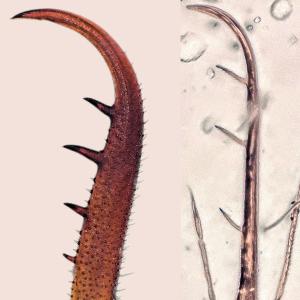Neuroptera: Greater insect diversity in the Cretaceous period
21 Apr 2023
An LMU team has studied the biodiversity of larvae from the insect group Neuroptera over the past 100 million years.
21 Apr 2023
An LMU team has studied the biodiversity of larvae from the insect group Neuroptera over the past 100 million years.

Examples for mouthparts in extant (left) and fossil (right) lacewing larvae. | © LMU / Haug
Human activity is currently driving a loss of natural diversity that some experts describe as the sixth major mass extinction event in the history of Earth. The decline in insects is particularly alarming: Insects are not just a highly diverse group of creatures in and off themselves, but they are also of tremendous ecological and economic importance.
The extent to which insects are disappearing can only be described as an exceptional situation. To better understand the underlying processes, it is therefore worth delving into past extinction events. Why? Because in the past, too, some groups of insects have gained in significance and diversified, while others have declined and forced to withdraw into the few remaining niches.
The latter point seems to have been the case for Neuroptera, whose modern-day representatives include green lacewings and antlions. Researchers have long suspected that the importance of this group of insects has tended to decrease since prehistoric times. Until now, however, there had been no strict quantitative test of this hypothesis.
Now, a team working with LMU biologists Professor Carolin Haug and Professor Joachim Haug have published a study in Scientific Reports documenting the diversity of Neuroptera from the Cretaceous period to the present day. For the first time, statistical analysis thus backs up scientists’ view of the diversity of these insects over the course of evolutionary history.
But how do we measure and compare the biological diversity of insects during the process of evolution? At best, we can only paint an incomplete picture of a tiny fraction of the biodiversity that prevailed in past ecosystems, because insect fossils are very rare. And although Jurassic Park may have nurtured expectations to the contrary, DNA for use in relatedness analyses can no longer be extracted from creepie-crawlies encased in amber during the Cretaceous period.
Lacewings are holometabolous insects whose larvae differ considerably in terms of appearance and lifestyle from adults. Whereas many lacewings pollinate flowers after metamorphosis, their larvae are often fierce predators – as is apparent from their strikingly stylet-like mouthparts. Precisely the mouthparts of these larvae became the focus of the researchers’ attention. “Unfortunately, the larval phase is often rather neglected in such analyses,” Joachim Haug says. “Yet the larvae in particular often display morphological attributes that we can use as a very informative data basis.”
The basic idea is simple: Different forms are a marker for biodiversity. The more different head shapes and stylets occur in lacewing larvae, the more ecological functions can be assumed for these creatures. It follows that, if an exceptionally large variety of head parts and mouthparts occur in a given geological period, it is reasonable to conclude that these insects occupied many different niches at that time. The principle holds true even if only a few specimens have survived and relatedness remains unclear.

Morphological diversity: lacewing larvae only known from the Cretaceous period (light blue), only from today (light red) or from both periods (white). | © LMU / Haug
The researchers measured the heads of more than 1,000 larvae, including all the nearly 300 fossilized lacewing larvae that are known worldwide and 800 specimens that are still alive today. In this way, they were able to confirm that the diversity of lacewing larvae has indeed declined in the last 100 million years.
“Although our glance into the past is limited to a small sample size and very specific regions around the globe, we can nevertheless detect greater morphological diversity among lacewing larvae in the Cretaceous period,” Carolin Haug says. “So, it is probable that actual diversity was in fact substantially greater in the past.” However, the overall picture of lacewing history is complex: Whereas their diversity as a whole has definitely decreased, some lineages of Neuroptera have diversified and thus gained in importance.
“Our work also showed how much potential lies in the morphological study of insect larvae,” Carolin Haug adds. “Quantitative morphology can reveal changes that cannot be quantitatively recorded within a taxonomic framework.”
Carolin Haug, Florian Braig, Joachim T. Haug Quantitative analysis of lacewing larvae over more than 100 million years reveals a complex pattern of loss of morphological diversity. Scientific Reports, 2023.